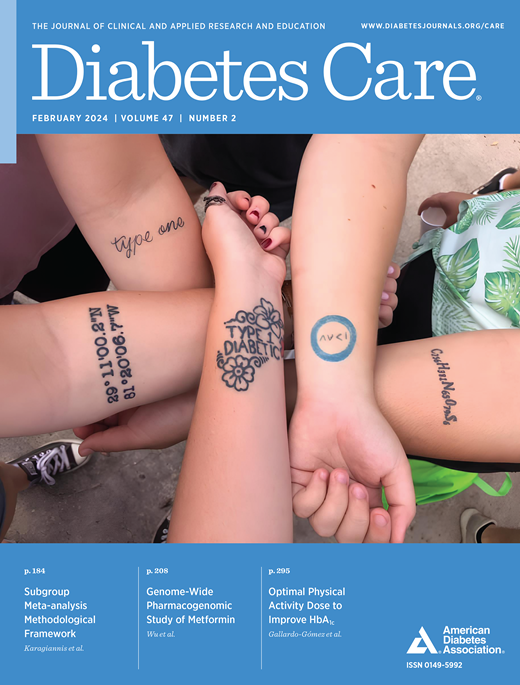Comparison of Insulin Titration Strategies for Glycemic Control in Type 2 Diabetes: A Systematic Review and Network Meta-analysis
IF 16.6
1区 医学
Q1 ENDOCRINOLOGY & METABOLISM
引用次数: 0
Abstract
BACKGROUND Adjusting basal insulin doses is essential for lowering blood glucose while minimizing the risk of hypoglycemia. Despite various basal insulin titration strategies being available, their comparative effectiveness remains unclear. PURPOSE To compare the effectiveness of different basal insulin titration strategies on glycemic control in patients with type 2 diabetes. DATA SOURCES PubMed, Embase, Cochrane Central Register of Controlled Trials (CENTRAL), CINAHL, and EBSCO Open Dissertations were searched from inception to January 2024. STUDY SELECTION We included published trials with evaluation of basal insulin titration strategies for glycemic control in type 2 diabetes. DATA EXTRACTION Data on HbA1c and severe hypoglycemia were extracted. DATA SYNTHESIS Studies were categorized with the theme, intensity, and provider/platform (TIP) framework. “Theme” referred to conventional titration (Conv) or self-titration (ST), “intensity” was categorized as high (Conv, >1/month; ST, ≥2/week) or low (Conv, ≤1/month; ST, <2/week), and for “provider/platform” categories included supported by health care provider (HCP for Conv or S-HCP for ST), patient led (Pt), and supported by application (S-App). The ST/High/S-HCP strategy resulted in the greatest HbA1c reduction in comparison with all others (e.g., ST/High/S-App, mean difference −0.75 [95% CI −1.26, −0.25], and Conv/Low/HCP, −1.19 [95% CI −1.67, −0.72]). Severe hypoglycemia risk did not differ significantly across strategies. LIMITATIONS The number of studies per network meta-analysis was limited, and not all TIP combinations were evaluated. CONCLUSIONS Self-titration at least twice a week with health care provider support leads to superior HbA1c reduction in comparison with other strategies, without increasing the risk of severe hypoglycemia. This approach should be considered for clinical practice, where appropriate, to achieve optimal glycemic control in patients with type 2 diabetes.2型糖尿病胰岛素滴定控制血糖策略的比较:系统综述和网络荟萃分析
背景:调整基础胰岛素剂量对于降低血糖和降低低血糖的风险至关重要。尽管有多种基础胰岛素滴定策略可用,但其相对有效性尚不清楚。目的比较不同基础胰岛素滴定策略对2型糖尿病患者血糖控制的效果。检索PubMed, Embase, Cochrane Central Register of Controlled Trials (Central), CINAHL和EBSCO Open dissertation,检索时间从成立到2024年1月。研究选择:我们纳入了已发表的评价2型糖尿病患者基础胰岛素滴入策略控制血糖的试验。提取HbA1c和严重低血糖的数据。数据综合研究按主题、强度和提供者/平台(TIP)框架进行分类。“主题”指常规滴定(Conv)或自滴定(ST),“强度”分类为高(Conv, 1/月;ST,≥2/周)或低(Conv,≤1/月;ST, <;2/周),以及“提供者/平台”类别,包括由医疗保健提供者支持(Conv为HCP或ST为S-HCP),患者主导(Pt)和应用程序支持(S-App)。与所有其他策略相比,ST/High/S-HCP策略导致最大的HbA1c降低(例如,ST/High/S-App,平均差为- 0.75 [95% CI - 1.26, - 0.25], Conv/Low/HCP,平均差为- 1.19 [95% CI - 1.67, - 0.72])。不同策略的严重低血糖风险没有显著差异。每个网络荟萃分析的研究数量有限,并不是所有的TIP组合都被评估。结论:与其他策略相比,在医护人员支持下每周至少进行两次自我滴定可显著降低HbA1c,且不会增加严重低血糖的风险。在适当的情况下,这种方法应被考虑用于临床实践,以实现2型糖尿病患者的最佳血糖控制。
本文章由计算机程序翻译,如有差异,请以英文原文为准。
求助全文
约1分钟内获得全文
求助全文
来源期刊

Diabetes Care
医学-内分泌学与代谢
CiteScore
27.80
自引率
4.90%
发文量
449
审稿时长
1 months
期刊介绍:
The journal's overarching mission can be captured by the simple word "Care," reflecting its commitment to enhancing patient well-being. Diabetes Care aims to support better patient care by addressing the comprehensive needs of healthcare professionals dedicated to managing diabetes.
Diabetes Care serves as a valuable resource for healthcare practitioners, aiming to advance knowledge, foster research, and improve diabetes management. The journal publishes original research across various categories, including Clinical Care, Education, Nutrition, Psychosocial Research, Epidemiology, Health Services Research, Emerging Treatments and Technologies, Pathophysiology, Complications, and Cardiovascular and Metabolic Risk. Additionally, Diabetes Care features ADA statements, consensus reports, review articles, letters to the editor, and health/medical news, appealing to a diverse audience of physicians, researchers, psychologists, educators, and other healthcare professionals.
 求助内容:
求助内容: 应助结果提醒方式:
应助结果提醒方式:


